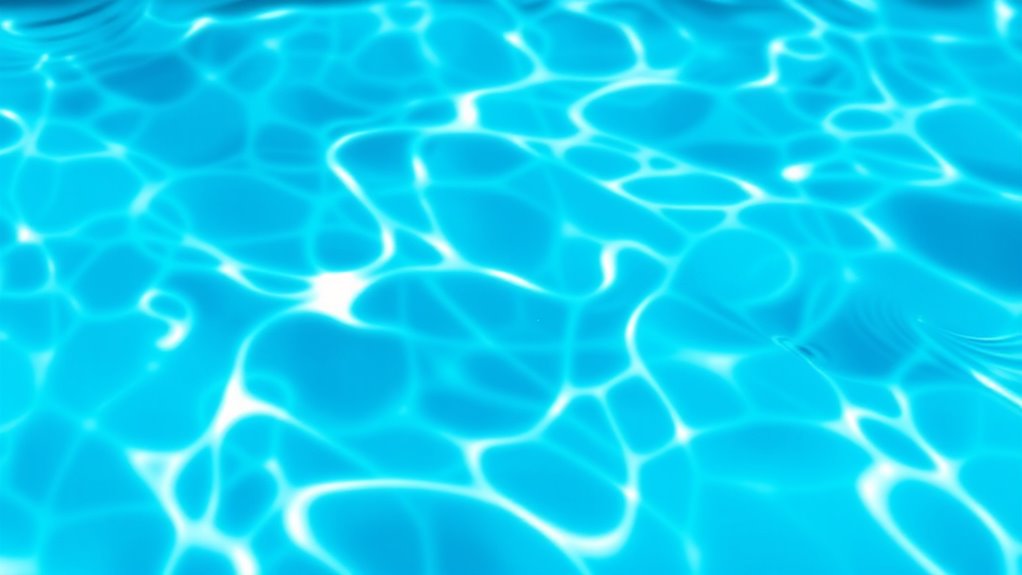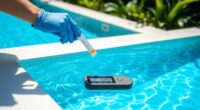Understanding pool water chemistry is key to keeping your pool safe and sparkling. You need to monitor and balance pH (ideally 7.2–7.6), alkalinity, calcium hardness, and sanitizer levels regularly. Proper adjustments prevent issues like cloudiness, algae, or equipment damage. Stabilizers like cyanuric acid protect chlorine from sunlight. Staying on top of these factors helps maintain clear, healthy water. Continue exploring these concepts to become confident in your pool’s chemistry and upkeep.
Key Takeaways
- Regularly test and adjust pH (7.2–7.6), alkalinity, and sanitizer levels to maintain water balance and clarity.
- Proper calcium hardness (200–400 ppm) prevents scaling, cloudiness, and equipment damage.
- Chlorine or alternative sanitizers keep water safe by controlling bacteria and algae growth.
- Stabilizers like cyanuric acid protect chlorine from sunlight, extending its effectiveness outdoors.
- Consistent water chemistry monitoring ensures a healthy, comfortable swimming environment.
Understanding Basic Pool Water Chemistry

Understanding basic pool water chemistry is essential for maintaining a clean and safe swimming environment. You need to know how the water interacts with chemicals to prevent issues like algae growth, cloudy water, or bacteria buildup. Key measurements include total alkalinity, calcium hardness, and pH levels. These factors influence how well disinfectants work and how water feels on your skin. Regular testing with a reliable kit helps you keep these levels within the ideal range. If any levels are off, you can adjust with the appropriate chemicals to restore balance. Staying on top of your pool’s chemistry prevents costly repairs and keeps your pool inviting. Proper water testing techniques are crucial for accurate results and effective maintenance. Incorporating professional-grade equipment and staying informed about industry trends can further optimize your pool care routine. Additionally, understanding the interactions between chemicals helps prevent common issues such as foaming or staining, ensuring a more enjoyable swimming experience. Regularly checking your water chemistry also helps you avoid water imbalance, which can lead to more serious problems over time. Remember, a well-balanced pool isn’t just about cleanliness; it’s about ensuring everyone enjoys a safe and healthy swim.
The Importance of Ph Balance
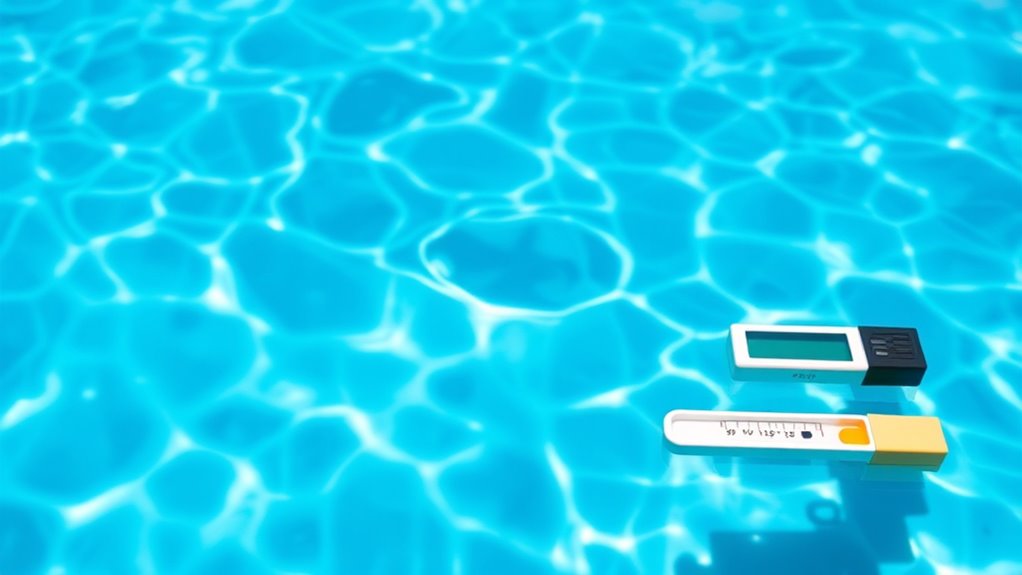
Maintaining proper pH levels keeps your pool comfortable and safe for swimmers. When the pH gets too high or low, it can cause skin and eye irritation or damage your equipment. Staying on top of pH balance helps prevent these issues and keeps your pool water clean. Regular testing and adjusting the pH with appropriate chemicals are essential for optimal water quality, much like maintaining effective filter replacement indicators in air purifiers to ensure ongoing efficiency. Proper tuning of your pool’s chemical levels can also improve equipment longevity and overall water clarity. Additionally, understanding how contrast ratio influences overall image quality can be compared to balancing pH levels for a clear and comfortable swimming environment. Just as using the right earplugs for concerts protects your hearing, maintaining balanced pH levels protects your pool’s integrity and user comfort.
Ph Levels and Comfort
The pH level of your pool water directly impacts how comfortable and safe it feels for swimmers. When the pH is balanced between 7.2 and 7.6, water feels soft, smooth, and pleasant. If the pH is too low, the water becomes acidic, causing skin irritation and eye discomfort. Conversely, high pH makes water feel dull and can lead to cloudy water, reducing visibility. Maintaining proper pH helps prevent irritation and guarantees that sanitizers work effectively. Regular testing and adjustments keep your pool inviting. Proper pH balance also ensures that air purifiers operate efficiently in indoor environments, promoting healthier living spaces. Additionally, consistent pH monitoring can help identify digital literacy issues among users who may need assistance with testing kits or adjusting chemicals. Being aware of local retail hours can also aid in sourcing necessary chemicals promptly to maintain optimal water quality. Understanding water chemistry principles can further improve maintenance routines and ensure a safe swimming experience. Moreover, proper pH levels can also reduce the formation of harmful chemical residues that might otherwise accumulate in the pool system.
Imbalance Effects on Pool
When your pool’s pH level is off-balance, it can cause a cascade of problems that affect water quality and swimmer comfort. Low pH makes water acidic, leading to skin irritation, eye redness, and corrosion of pool equipment. High pH results in cloudy water, reduced sanitizer effectiveness, and scaling on surfaces and equipment. Imbalanced pH also encourages algae growth and bacteria proliferation, making your pool less safe. You might notice a strong chemical smell or difficulty maintaining proper sanitizer levels. These issues can increase maintenance costs and shorten equipment lifespan. Keeping your pH calibrated ensures clear water, effective sanitation, and a comfortable swimming experience. Regular testing and adjusting pH levels are essential to prevent these imbalance effects and keep your pool in prime condition. Proper pH balance is crucial for maintaining water chemistry, which directly impacts overall pool health. Understanding tuning Hyundai models can be compared to maintaining balanced water chemistry, as both require precise adjustments to optimize performance and longevity. Additionally, using appropriate test kits helps ensure accurate pH readings for optimal pool maintenance. Staying informed about home security systems can help you safeguard your investment and ensure peace of mind while enjoying your pool.
Total Alkalinity and Its Role
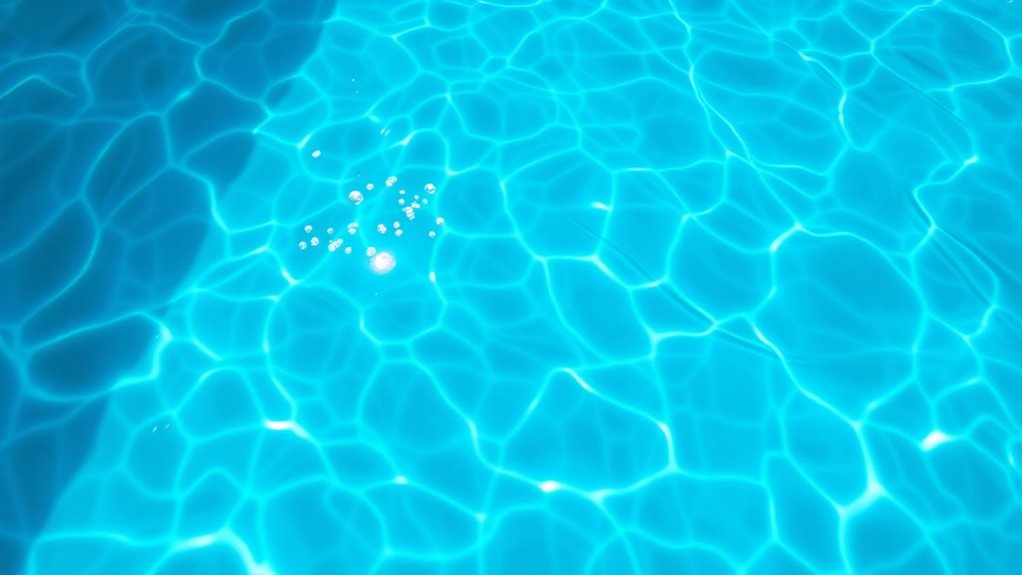
Total alkalinity measures the water’s ability to neutralize acids, acting as a buffer that helps stabilize pH levels in your pool. Maintaining proper alkalinity prevents sudden pH swings that can cause cloudy water, corrosion, or scaling. When alkalinity is too low, pH can drop rapidly, leading to corrosive water that damages equipment. If it’s too high, pH becomes difficult to adjust, resulting in cloudy water and reduced sanitizer effectiveness. To keep your pool balanced, monitor alkalinity regularly and adjust as needed with alkali or acid. Proper alkalinity levels create a stable environment, making it easier to maintain clean, clear water. Remember, consistent testing and adjustments keep your pool chemistry in check for ideal swimming conditions.
Maintaining proper alkalinity stabilizes pH and protects pool equipment from damage.
- Prevents rapid pH fluctuations
- Protects pool equipment from corrosion
- Ensures sanitizer efficiency
Chlorine and Other Sanitizers

Chlorine is the most common sanitizer for keeping your pool safe, but other options like bromine and salt systems are also popular. Maintaining proper chlorine levels is essential to prevent bacteria growth and keep the water clear. You’ll also want to contemplate alternative methods, such as UV or ozone systems, to enhance sanitation without over-relying on chemicals. These methods can provide additional cybersecurity protection for your pool equipment and data. Additionally, understanding pool water chemistry can help you make informed decisions when purchasing pool supplies online.
Sanitizer Types and Uses
Sanitizers are essential for maintaining safe and clean pool water, with chlorine being the most commonly used option due to its proven effectiveness. However, other sanitizers like bromine, biguanides, and salt chlorinators also serve specific needs. Bromine works well in hot water and spa environments, offering stability at higher temperatures. Biguanides provide a gentler alternative for those sensitive to chlorine but require careful maintenance. Salt chlorinators generate chlorine naturally from salt, reducing the need for adding chemicals directly. Each sanitizer type has unique benefits and considerations, so choosing the right one depends on your pool’s usage, your sensitivity, and maintenance preferences. Proper selection guarantees safe water, minimizes chemical odors, and maintains clarity for your swimming enjoyment.
- Bromine for hot water and spas
- Biguanides for sensitive skin
- Salt chlorinators for reduced chemical handling
Maintaining Proper Chlorine Levels
Maintaining proper sanitizer levels is essential for ensuring your pool water stays safe, clear, and free of harmful bacteria. You should regularly test your chlorine levels using test strips or a liquid test kit, aiming for a range of 1 to 3 ppm (parts per million). Too little chlorine allows bacteria and algae to thrive, while too much can cause skin irritation and damage pool equipment. Keep chlorine levels stable by adding sanitizer as needed, especially after heavy use or rain. Be mindful of sunlight, which can break down chlorine, and consider using stabilizers like cyanuric acid to protect it. Consistent testing and adjusting help you maintain balanced water chemistry, ensuring a safe and enjoyable swimming environment.
Alternative Sanitization Methods
While chlorine remains the most common method for disinfecting pool water, many pool owners consider alternative sanitization options to reduce chemical use or improve water quality. These methods can be effective and environmentally friendly, but they require proper understanding and maintenance. Some popular alternatives include saltwater systems, which generate chlorine naturally; mineral purifiers that use natural minerals to control bacteria; and ultraviolet (UV) systems that deactivate pathogens with light.
- Saltwater systems produce a steady supply of chlorine, reducing the need for adding chemicals manually
- Mineral purifiers help keep water clear and inhibit algae growth without harsh chemicals
- UV systems offer chemical-free disinfection by destroying bacteria and viruses with ultraviolet light
Managing Calcium Hardness

Managing calcium hardness is essential for keeping your pool water balanced and preventing equipment damage. Too much calcium causes cloudy water, scaling on your pool surfaces, and clogging filters. Too little calcium makes the water corrosive, risking damage to your pool’s plumbing and equipment. To maintain ideal levels, test your calcium hardness regularly using a reliable test kit. Ideally, calcium hardness should be between 200 and 400 ppm. If levels are too high, you can dilute the water with fresh, softened water or partially drain and refill your pool. If levels are too low, add a calcium hardness increaser or calcium chloride to raise the levels. Consistent management ensures your pool stays clear, healthy, and equipment lasts longer. Regular testing and adjustments are key to achieving the right balance.
Monitoring Cyanuric Acid Levels

Monitoring cyanuric acid levels is an important step in keeping your pool water balanced and protecting your chlorine from rapid degradation. When cyanuric acid levels are too low, your chlorine breaks down quickly, reducing its effectiveness. Conversely, high levels can hinder chlorine’s ability to sanitize. To maintain ideal levels, test your cyanuric acid regularly using a reliable test kit. Keep the levels between 30-50 ppm for most outdoor pools. Remember, consistent monitoring helps you avoid issues like algae growth or bacteria buildup. Be aware of environmental factors, such as heavy rain or sunlight, which can influence cyanuric acid levels. By staying vigilant, you ensure your pool remains clean, safe, and properly sanitized. Proper management of cyanuric acid helps prolong your chlorine’s lifespan and keeps your water clear.
Recognizing and Correcting Imbalances
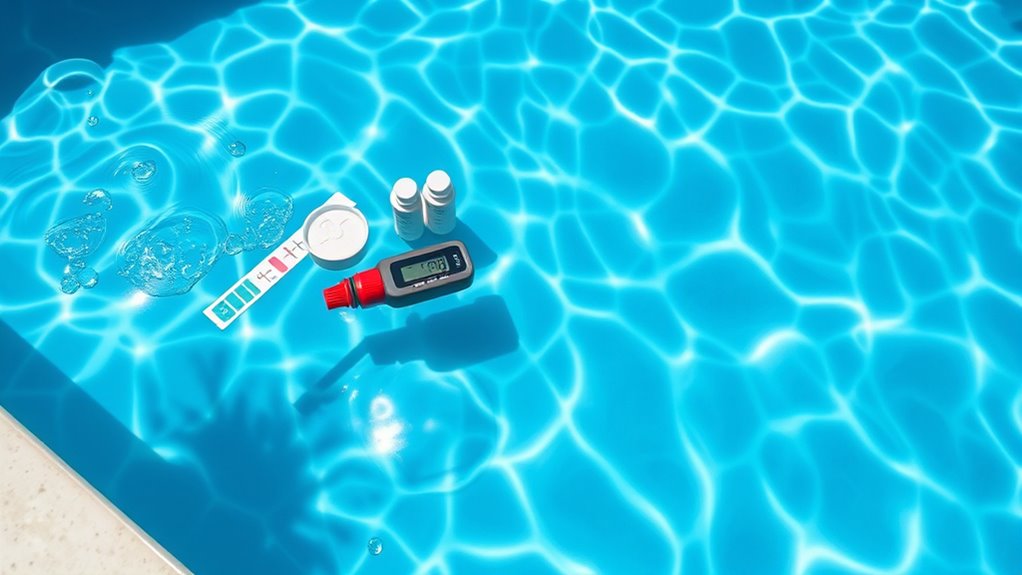
Recognizing and correcting water imbalances promptly is essential for maintaining a safe and healthy pool. When your water’s pH, alkalinity, or sanitizer levels are off, it can cause cloudy water, algae growth, or skin irritation. Regularly inspect your water for changes in clarity, color, or smell. Use test kits to identify issues quickly. Here’s a quick guide:
| Imbalance | Correction Method |
|---|---|
| High pH (above 7.6) | Add pH reducer (acid) |
| Low pH (below 7.2) | Add pH increaser (alkaline) |
| High alkalinity | Add acid to lower alkalinity |
| Low sanitizer levels | Add sanitizer (chlorine or bromine) |
| Cloudy water | Adjust pH, shock, or filter thoroughly |
Stay vigilant to keep your pool inviting and safe.
Testing Your Pool Water Effectively

To guarantee your pool water stays balanced and safe, testing it regularly is essential. Proper testing helps you catch imbalances early, preventing issues like algae growth or corrosion. Use reliable test kits or digital testers for accurate readings. Always follow the instructions carefully to ensure precise results. Test your water at different times—preferably daily during heavy use or weather changes. Keep a record of your test results to track trends over time. This helps you determine when to adjust chemicals and maintain ideal water quality. Remember, consistent testing is the foundation of effective pool maintenance.
- Use test strips or liquid test kits for quick results
- Test for pH, chlorine, alkalinity, and stabilizer levels
- Record results to monitor changes over time
Tips for Maintaining Optimal Water Chemistry

Maintaining ideal water chemistry requires proactive adjustments and consistent attention to detail. Regularly test your water and adjust chemicals promptly to keep pH, alkalinity, and sanitizer levels balanced. Keep a routine schedule for adding chemicals, especially after heavy use or storms. Proper filtration and circulation help distribute chemicals evenly, preventing spots and algae growth. Use the table below as a quick reference for common adjustments:
| Issue | Solution | Frequency |
|---|---|---|
| High pH | Add pH reducer (acid) | As needed, weekly |
| Low sanitizer levels | Shock the pool or add sanitizer | Weekly or after heavy use |
| Cloudy water | Check filter and adjust chemicals | Daily until clear |
| Algae growth | Brush and shock, maintain sanitizer | Weekly or as needed |
Frequently Asked Questions
How Often Should I Test My Pool Water?
You should test your pool water at least twice a week during peak usage or hot weather to guarantee proper balance. Regular testing helps you catch issues early, like pH imbalance or algae growth. Keep a testing kit handy, and don’t forget to check after heavy rain or storms. Consistent testing keeps your pool safe, clean, and inviting, so you can enjoy swimming without worries.
What Are the Signs of Chemical Imbalance in My Pool?
You might notice your pool water looks cloudy or murky, which signals a chemical imbalance. If the water causes skin or eye irritation, that’s another red flag. Also, if your pH or chlorine levels are off, you may see algae growth or a strong chemical smell. Regular testing helps you catch these issues early, ensuring your pool stays clean, safe, and inviting.
Can Natural Pool Treatments Replace Traditional Chemicals?
You’re wondering if natural pool treatments can replace traditional chemicals. While natural methods like salt chlorinators, mineral systems, and UV sterilizers reduce chemical use, they often don’t eliminate the need entirely. These systems can effectively maintain water quality, but you’ll still need to monitor pH and sanitation levels regularly. Combining natural treatments with careful testing can create a healthier pool environment, though complete replacement depends on your specific needs and water conditions.
How Does Weather Affect Pool Water Chemistry?
Weather plays a big role in your pool’s water chemistry. When it’s sunny, UV rays break down chemicals faster, so you might need to add more disinfectants. Rain can dilute chemicals and introduce dirt, affecting balance. Wind stirs up debris, raising your filtration needs. Cold weather slows chemical reactions, making balancing trickier. To keep your pool healthy, regularly test and adjust your chemicals based on current weather conditions.
What Safety Precautions Are Necessary When Handling Pool Chemicals?
Handling pool chemicals is like walking a tightrope—you need balance and caution. Always wear protective gear, such as gloves and goggles, to prevent skin and eye irritation. Store chemicals in a cool, dry, well-ventilated area away from children and pets. Never mix chemicals directly; it’s like mixing unknown ingredients—dangerous. Follow manufacturer instructions precisely, and always add chemicals to water, not water to chemicals, to avoid dangerous reactions.
Conclusion
Keeping your pool water balanced is like tending a delicate garden—you need to regularly check and nurture it. By understanding and managing pH, alkalinity, chlorine, calcium hardness, and cyanuric acid, you’ll create a sparkling oasis everyone can enjoy. Think of water chemistry as the secret recipe for perfect pool fun. Stay attentive, test often, and adjust as needed—your pool will thank you with clear, inviting waters that beckon you in every time.
